Here at our Costa Rican mountain retreat, tranquility reigns supreme. Lush greenery, whispering winds, and the sweet songs of exotic birds create a symphony of serenity. But amidst this calming chorus, you might encounter another vocalist with a distinct flair – the Great-tailed Grackle.
This bold, blackbird with an impressive, long tail is a common sight throughout Costa Rica, including the mountains where our retreat resides. While some might find their boisterous calls disruptive to the peaceful ambiance, these intelligent creatures hold a unique place in the Costa Rican ecosystem, and getting to know them can be quite rewarding.
A Master of Adaptation:
The Great-tailed Grackle (locally known as “zanate”) is a testament to adaptability. Originally found in open areas like wetlands and beaches, they’ve thrived alongside human development. Today, you’ll see them scavenging for scraps in urban parks, strutting confidently on golf courses (much to the chagrin of some golfers!), or even joining you on our retreat’s outdoor dining area, hoping to snatch a stray crumb.
Dressed to Impress (Except the Ladies):
The males of the species are the true attention-grabbers. Their glossy black plumage gleams in the sunlight, and their ridiculously long tail feathers, often held in a dramatic V-shape, add a touch of the theatrical. Females, however, are a study in modesty. They sport a subdued brown coat with a hint of pale color around the eyebrows and throat.
A Complex Songster:
While their loud calls might not be everyone’s cup of tea, the Great-tailed Grackle is a surprisingly versatile vocalist. Their repertoire goes beyond just squawks and screeches. They can mimic other bird calls, and even incorporate whistles and rattles into their complex songs.
Friend or Foe? A Little of Both:
The Great-tailed Grackle’s relationship with humans is a complex one. Farmers consider them a nuisance, as they’ll readily raid crops. Yet, their omnivorous diet includes insects that can damage agricultural fields, making them a natural form of pest control.
A Sign of a Thriving Ecosystem:
Despite their occasional mischief, the abundance of Great-tailed Grackles is a positive sign. It indicates a healthy ecosystem with ample food sources. Here at our retreat, we appreciate their presence as a reminder of the vibrant tapestry of life that surrounds us.
Tips for Observing Great-tailed Grackles:
- Keep an eye out for them foraging on the ground, perched on trees, or even soaring in loose flocks.
- Listen for their loud, varied calls, which can sound like a mix of whistles, rattles, and squawks.
- Observe their social behavior. They often travel in groups, squabbling amongst themselves and engaging in playful chases.
The Great-tailed Grackle might not be the most sought-after bird in Costa Rica, but they add a touch of character to the natural world around our mountain retreat. By understanding their role in the ecosystem and appreciating their unique adaptations, you can learn to find a certain charm in these bold, black bandits.
For more information, please view our comprehensive guide about the birds of Costa Rica







